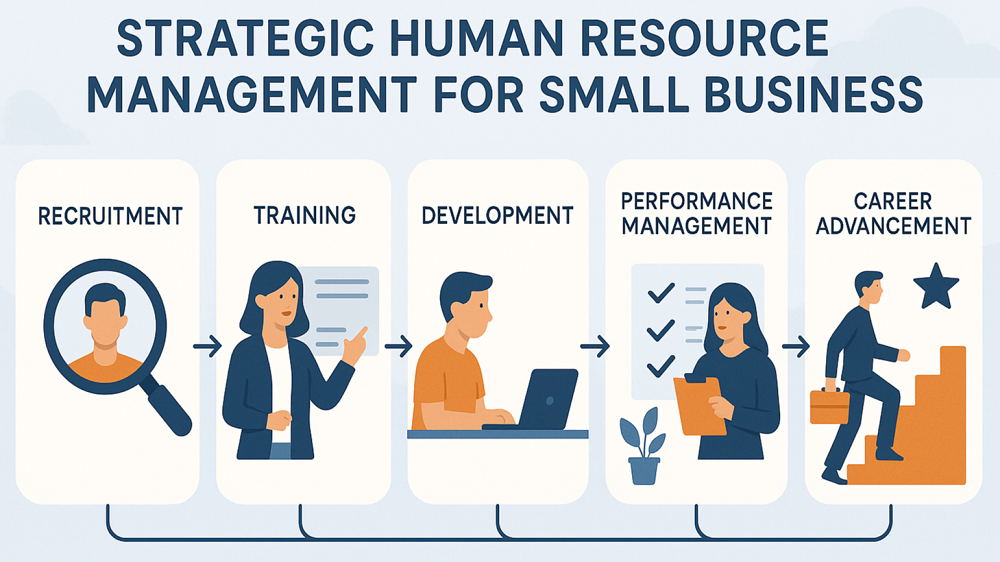Strategic Human Resource Management (SHRM) is the process of aligning human resources practices with an organization’s long-term business goals. For small businesses, adopting SHRM principles can provide a significant advantage, especially when every team member plays a critical role in the company’s success.
While small businesses often focus on immediate needs such as filling open positions or processing payroll, SHRM encourages business owners to take a proactive and holistic view of how people, performance, and culture influence outcomes. Let’s take a look at what SHRM is, why it matters for small businesses, and how to implement it step by step.
What Is Strategic Human Resource Management?
Strategic Human Resource Management refers to the deliberate design and implementation of HR practices that support long-term organizational objectives. This approach contrasts with traditional HR management, which tends to focus on day-to-day administrative tasks such as record keeping, recruitment, and benefits administration.
In SHRM, every HR policy, from how you hire to how you conduct performance reviews, is shaped by and contributes to the overall business strategy. The goal is to build and manage a workforce that helps the business succeed both now and in the future.
For example, if your goal is to open a second location in the next year, SHRM would involve planning for leadership development, staff training, and recruitment strategies well in advance, rather than scrambling to find people after the expansion begins.
Why Strategic HR Management Is Crucial for Small Businesses
Small business owners often delay strategic HR planning because they are busy managing operations or because they assume HR strategy is only necessary for larger companies. However, the consequences of not having a strategic approach to human resources can be severe. These may include high turnover, slow hiring processes, poor employee performance, low morale, and even legal risk due to compliance issues.
Below are key reasons why small businesses need SHRM:
1. It Aligns HR Efforts with Business Goals
SHRM ensures that hiring, training, and retention practices directly support where the business is going. If your business intends to offer new services or enter new markets, your HR practices need to support that shift through the right talent and organizational structure.
2. It Enhances Employee Retention
Employees are more likely to stay in environments where they understand their role, see a path for development, and feel that leadership is invested in their success. SHRM addresses all of these elements by establishing structured onboarding, feedback systems, and training plans.
3. It Prepares the Business for Growth
Growth often comes with complexity. Whether it is hiring new team members or promoting from within, SHRM helps you prepare for these transitions in advance. You can identify which positions are essential, determine how responsibilities will shift, and plan for knowledge transfer.
4. It Reduces Risk and Ensures Compliance
Employment laws apply to businesses of all sizes. Without formal HR processes, small businesses are vulnerable to legal issues related to employee classification, wage laws, harassment claims, and more. SHRM involves creating documentation and systems that minimize this risk.
Key Components of SHRM for Small Businesses
Implementing SHRM in a small business does not require a large HR team or expensive software. It requires thoughtful planning and consistent execution across several essential areas.
Workforce Planning
Workforce planning involves identifying the current and future human capital needs of your business. This means understanding not only the number of employees you need but also the types of skills and experiences required to meet business goals.
Key actions:
- Analyze current roles and identify gaps in capability.
- Forecast staffing needs based on business projections.
- Prioritize hiring based on upcoming projects or expansion plans.
This process should happen at least once per year and be updated as your business goals evolve.
Talent Acquisition and Recruitment
Hiring the right people is critical in small businesses where each employee has a significant impact. SHRM calls for hiring practices that are consistent, fair, and strategic.
Key actions:
- Develop clear job descriptions that align with business goals.
- Standardize your hiring process to evaluate both skills and cultural fit.
- Use structured interviews to reduce bias and improve decision-making.
You may also consider developing an employer value proposition — a statement that communicates what makes your company an attractive place to work. This helps attract candidates who align with your values and mission.
Onboarding and Orientation
First impressions matter. An effective onboarding process helps new employees understand their responsibilities, connect with coworkers, and feel confident in their new role.
Key actions:
- Provide a detailed orientation plan that includes policies, procedures, and job expectations.
- Assign a mentor or point of contact during the first few weeks.
- Schedule follow-up check-ins to answer questions and gather feedback.
Strong onboarding has been shown to increase employee retention and productivity within the first 90 days of employment.
Performance Management
Performance management should be an ongoing process, not a once-a-year formality. The goal is to help employees understand expectations, receive regular feedback, and improve continuously.
Key actions:
- Set specific, measurable, and time-bound performance objectives.
- Hold quarterly check-ins to discuss progress, challenges, and support needs.
- Offer constructive feedback and recognize strong performance.
Performance management should be tied directly to the business’s key performance indicators. If one of your goals is to reduce customer churn, your team’s performance reviews might include customer satisfaction scores or response times.
Learning and Development
Investing in employee development helps your business grow from within. In a small business, where employees often take on multiple roles, cross-training and professional development are especially important.
Key actions:
- Offer skill-building opportunities such as online courses, workshops, or internal training sessions.
- Create individual development plans based on each employee’s career goals and company needs.
- Allocate time and budget for learning activities.
Developing internal talent also reduces hiring costs and boosts employee morale.
Compensation and Benefits
While many small businesses cannot match corporate salaries, they can offer competitive compensation packages that include flexibility, recognition, and benefits that matter to employees.
Key actions:
- Conduct regular reviews to ensure your pay structure is fair and competitive.
- Consider non-monetary benefits such as remote work options, flexible scheduling, or wellness programs.
- Communicate clearly about total compensation, including any bonuses, time off, and health benefits.
Transparency in compensation helps build trust and reduce employee dissatisfaction.
Compliance and Documentation
Compliance is often overlooked in small businesses, but it is essential to protect both the business and its employees. SHRM includes formalizing HR policies and ensuring compliance with all labor regulations.
Key actions:
- Create and maintain an employee handbook.
- Ensure compliance with federal, state, and local employment laws.
- Keep accurate records of hiring, performance, compensation, and disciplinary actions.
Legal compliance also includes safety practices, anti-discrimination policies, and rules regarding overtime, breaks, and leave.
How to Implement SHRM in a Small Business
Putting SHRM into action requires intentional planning. The following steps provide a framework for implementation.
Step 1: Define Strategic Objectives
Identify your top business goals for the next one to three years. Examples include increasing revenue by a certain percentage, expanding into a new geographic area, or launching a new product or service.
Once you have clear goals, consider how your workforce needs to evolve in order to achieve them.
Step 2: Evaluate Current HR Practices
Conduct a thorough audit of your existing HR processes. This should include:
- How hiring decisions are made
- Whether job descriptions are up to date
- How performance is measured
- What policies are in place
- How employee issues are handled
Use this information to determine strengths, weaknesses, and areas for improvement.
Step 3: Prioritize Key Initiatives
You may not be able to overhaul everything at once. Identify the most critical areas to address first. For example, if your business has experienced high turnover, focus on onboarding and performance management. If you are about to hire several people, prioritize recruitment and job design.
Set specific milestones and assign responsibilities.
Step 4: Develop Documentation
Create the necessary documents to support your HR strategy. This might include:
- Updated job descriptions
- An employee handbook
- Offer letter templates
- Performance review forms
- Onboarding checklists
Keep documents accessible and review them at least once per year.
Step 5: Communicate with Employees
Change can cause uncertainty, so it is important to communicate clearly and regularly with your team. Explain why changes are happening, how they align with business goals, and how employees will benefit.
Create opportunities for feedback and adjust your plans based on what you hear.
Step 6: Monitor Progress and Make Adjustments
Measure the effectiveness of your SHRM initiatives over time. This can include tracking metrics such as:
- Employee turnover rate
- Time to fill open roles
- Productivity or revenue per employee
- Employee satisfaction survey results
Review your progress quarterly and make necessary adjustments.
Final Thoughts
Strategic Human Resource Management is not a luxury for small businesses. It is a necessity for those that want to grow sustainably, retain talented employees, and build a resilient organization. By aligning HR practices with your long-term business goals, you can turn people into your strongest competitive advantage.
You do not need a large HR team or expensive tools to practice SHRM. What you need is a clear plan, thoughtful execution, and a commitment to continuous improvement.
If you are unsure where to begin, consider working with a consultant who understands the needs of small businesses. A structured approach to SHRM can help you save time, reduce risk, and achieve your goals more effectively.
Sources:


